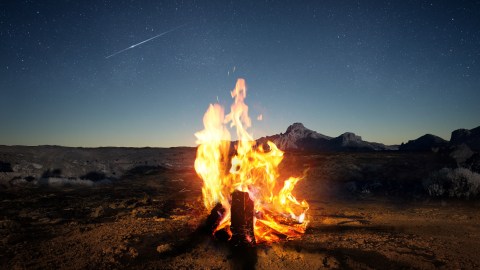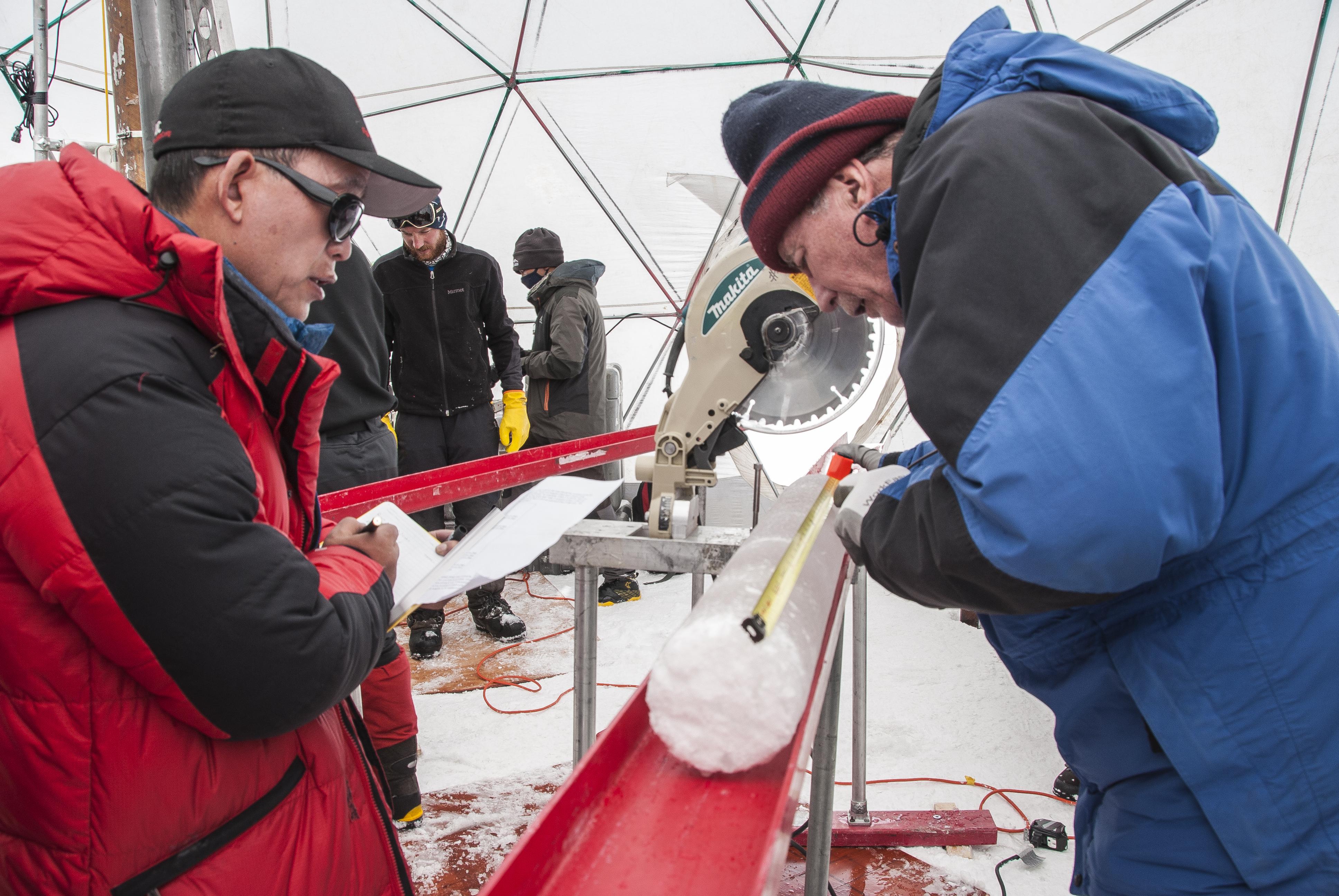The invention that made us human: fire

- The earliest evidence for fire dates back nearly 440 million years.
- Our hominin ancestors first used natural wildfires to flush out prey and forage for food.
- Richard Wrangham’s cooking hypothesis suggests that a ready supply of cooked food allowed the Homo lineage to develop its large, complex brains.
Of humanity’s greatest inventions, fire remains as important today as in the time of our ancient ancestors — if not as apparent.
We have replaced the hearth with electric ovens and central heating, but the burning of fossil fuels accounts for 63.5 percent of U.S. electricity generation. We still heat our homes and cook our food with fire — just in a more roundabout manner.
We even use fire in ways our ancestors couldn’t have imagined. The internal combustion engine has replaced animals and our own wobbly legs as the preferred method of travel. We can go farther in a day than the vast majority of our ancestors did in a lifetime and even escape the confines of our planet. Thanks to fire.
But fire has done more than create the energy that makes our lives comfortable. By one Harvard professor’s account, fire altered the course of our evolution.
Fire, a brief history
First, some Chem 101. Fire requires three elements for its reaction: oxygen, fuel, and a heat source. Since two of the three elements are provided naturally by plants, the history of fire became intricately tied to them.
Some of our earliest evidence for fire goes back 440 million years to the Silurian period when Earth’s climate stabilized and plants and animals began to move to land. Of note, this period provides the earliest fossil evidence of vascular plants.
From this point, fire becomes a recurrent phenomenon with times of high and low activity based on environmental conditions. During the Carboniferous period, atmospheric oxygen hit a record high of 31 percent and plants spread across the supercontinent Pangea, so charcoal records suggest a lot of fire activity during this period. Conversely, the pittance of charcoal from the Triassic period suggests low atmospheric oxygen and fewer plants.
Jumping a few million years to the late Miocene, hominins moved to the grasslands and began to further diverge from their ape relatives — likely due to the difference between the African savanna and the dense jungle. Here, they would have also encountered wildfires with far more regularity.
We didn’t start the fire
Low-hanging references aside, Billy Joel was on to something. Popular culture conjures the image of a caveman banging two stones together. Sparks fly, and then the eureka moment. Yet, our ancestors’ first usage of fire probably wasn’t a matter of control or invention. It was more likely opportunistic.
In a review for the Royal Society Philosophical Transactions B, J.A.J. Gowlett hypothesizes that hominins took advantage of natural wildfires for foraging. “For hominins,” he writes, “benefits could include retrieval of birds eggs, rodents, lizards and other small animals, as well as invertebrates. Although fire does not create such resources, it renders them far more visible, and chance cooking might well improve their digestibility.”
Gowlett notes that analogs to this behavior exist in the natural world today. Savanna chimpanzees use fires to locate resources, and several bird species follow fires to snatch up any prey flushed out by the smoke and flames. There has even been anecdotal evidence of some raptors, such as Australia’s “firehawks,” picking up smoldering wood from one fire and carrying it elsewhere to start another.
Early hominins would have also begun to discover fire’s properties by observing and interacting with these blazes. For example, if a meaty morsel proved too raw, they may have learned to place it on embers to continue the cooking process.
Given our early reliance on nature for fire, it’s little wonder that the theft of fire theme has appeared time and again in the world’s mythologies.
But we kept it burning
It’s difficult to follow the development of hominin control over fire because of what Gowlett calls its “disappearing act.” Fire isn’t as well preserved in the archeological record as, say, middens or flint tools. And progress was incremental, with fire control being learned in different places at different times.
Certain archeological sites have proffered a bounty of stone tools, suggesting long-term quartering. Such occupancy could mean hominins learned to at least maintain fire as far back as 2.5 million years ago. But direct evidence is scarce.
As we move forward, we see more evidence of hominins’ control over fire. Archaeologists have discovered campfire traces and charred animal and plant remains at Wonderwerk Cave in South Africa. These have been dated back to approximately one million years ago. And the oldest known hearth, found at Qesem Cave, Israel, dates back more than 300,000 years ago.
Interestingly, archeologists aren’t sure which hominin species got cozy at Qesem. “It is clearly different than [Homo] erectus and has affinities of both[Homo] sapiens and Neanderthals,” Ran Barkai, Tel Aviv archaeologist, told National Geographic. “Since Neanderthals appear very late in the Levant and are of European origin, and since the Qesem teeth bear more resemblance to early Homo sapiens in the Levant, we believe they are closer to Homo sapiens.”
Hearths and campfires tell us hominins could maintain fires for cooking and warmth. They do not, however, prove our ability to create fire. After transferring a brand from a wildfire, a tribe member could have been given fire duty and tasked with fueling the fire to prevent its extinguishing.
Good evidence for fire creation appears around 120,000 years ago when hominins had access to twine, a requisite to developing the bow drill. And archeologists have dated two types of glue, used in hafting, bark pitch, and gypsum plaster, to between 50 and 100,000 years ago. Neither of these can be prepared without fire.
At this point, Gowlett argues, the invention of fire belongs to our ancestors. “[A]n understanding is emerging that fire use is not a single technology or process, but that several scales of use, and probably several intensifying technologies, evolved over a long period, intertwined, and sometimes eventually became bound together,” he writes.
Fire (and food) for thought
But how did fire make us human? It allowed us to cook our food. That’s according to the cooking hypothesis proposed by Richard Wrangham, Ruth B. Moore Professor of Biological Anthropology at Harvard.
Cooked meats are easier to chew and digest; as a result, our bodies can extract more nutrients from the same amount of meat. Similarly, cooking vegetables increases levels of healthy stuff like antioxidants. That’s because the cooking process breaks down the plants’ cell walls and, like meat, makes them easier to digest and process. (Though, it is a tradeoff. Some veggies are healthier raw, and it depends on how you cook them.)
Wrangham argues that the ability to create cooked foods shaped the brains and bodies of our Homo ancestors. Since our ancestors spent less energy digesting foods and could draw out additional nutrients, they had more nutrients to spend, and evolution spent those dividends on maintaining larger brains — not to mention smaller teeth and jaws. Larger brains allowed us to process more information, create more dynamic social groups, and adjust to unfamiliar habitats. All of which benefited us evolutionarily.
With that said, the cooking hypothesis has its detractors. Some argue there is little proof that humans were cooking or maintaining fires in concurrence with Homo erectus’ brain-size explosion (roughly 1.5 million years ago). It’s also possible that a diet of raw meat and veggies could have provided the necessary nutrients for bigger brains.
Other hypotheses exist to explain the increase in hominin brain size. The social brain hypothesis, for example, argues our brains evolved to meet the challenges of living in large social groups. But even here, fire plays a role. Remember that before our ancestors could ignite fire, they had to maintain it. This required a division of labor, which is only possible in a species with a highly structured social network.
Fire may or may not ultimately prove to be principal in our evolutionary development. For any such hypothesis, more evidence is needed — though fire, cooked food, and social networks likely all played a part.
Without a doubt, fire has proved a primary mover in the evolution of civilization. It helped us migrate to climates that would otherwise prove inhospitable. It was essential to the development of cuisine, agriculture, metallurgy, architecture, and a host of other industries. In short, the invention of fire has taken humanity places no other species has gone.





